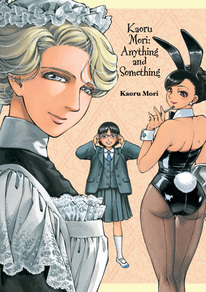Review
by Rebecca Silverman,Kaoru Mori: Anything and Something
GN
| Synopsis: |  |
||
In this collection of short stories, sketches, and research pieces, Mori tells the tales of a bunny girl who is perhaps not what she seems, a middle schooler who gets her first pair of glasses, a girl with a uniform that is much too big, and of course plenty of maids. |
|||
| Review: | |||
You never quite know what you're getting into with a short story collection. Even if all of the stories are by a single author (or in this case mangaka), the quality will be varied and the stories either too much or the same or a mix of good and not so good. Kaoru Mori: Anything and Something is no exception to this rule, blending some moments of quiet beauty with some that are either just odd or don't quite work. What is consistent is that her art is gorgeous throughout, even in the earliest of pieces, and some of the included sketches and signing sheets are exquisite. Ultimately your enjoyment of this book will come down to how you feel about short story collections, because while many of the tales in here are good, none are real stand-outs. The first three-quarters of the hardcover – which is the same size as Yen Press' editions of Mori's A Bride's Story and similarly dust-jacketed – is composed of the actual stories. These are primarily from special editions of Fellows! magazine with various themes; for example, “The Swimsuit Bought Long Ago” was originally published in Swimsuit Fellows!. Most of the stories are under twenty pages, with a couple coming in at under ten. Obviously this is not much space for Mori to tell a complete or a complex story, and most of them come off as a sort of manga flash fiction. “To Come to See,” the second in the book, is one of the more successful ones. Set in a contemporary middle school, the story focuses on Yucchi, a second year student who needs her first pair of glasses. Those of us who wear them will recognize the emotions that Yucchi feels as she finds that she can suddenly see not only the blackboard, but the details of the world around her. This relateability is also present in the aforementioned swimsuit story, in which an unnamed woman is persuaded by her unseen husband to model an old bathing suit. One of the shortest in the book, the story nonetheless conveys the feelings of both the woman and her husband and the loving nature of their relationship. “The Swimsuit Bought Long Ago” shares some distinct aspects with “Burrow Gentleman's Club” both in terms of art and style. In both stories the male characters are unseen, completely in the case of “Swimsuit” and with only bodies in the case of “Burrow.” This gives the illusion that the (sexy) women are speaking directly to the audience, creating a much more adult tone than in either of Mori's longer series. This is helped by the focus on the voluptuous lines of the women's bodies, with a clear focus on breasts and buttocks. Mori draws lushly proportioned women that are very pleasing to the eye, but the blatant sexuality on display here is a bit surprising. We see it again in the final short story, “Sumire's Flowers,” which Mori illustrated from a script by Satoshi Fukushima. This is the longest piece in the book and also the most elusive in terms of the plot. It appears to be about two disparate girls becoming friends, but there are slight yuri overtones and just what the title character's issue is is never fully discussed. Strangely for the longest story, it is also the one that feels the least complete. The final quarter of the book is made up of Mori's sketches (early ones of Amir are breathtaking), notes she wrote to thank people for attending her signings, some cards she drew for a manga retailer, and small comics about her research for Emma that she drew for various places. This are annotated by Mori, and while they are interesting, they also are something of a let down after the stories. What Yen Press calls “Mori's own brand of enthusiastic commentary” can get to be a bit much (why does she keep rolling on the floor?), but the time and effort it must have taken to translate some of the more technical information about Victorian corsets and fireplaces makes their inclusion impressive. Ultimately, Kaoru Mori: Anything and Something is more of a library read than a run out and buy. It is beautiful, yes, and some of the stories are very good, but on the whole it is neither compelling enough nor consistent enough to merit shelf space unless you are a major fan of Mori's artwork, in which case it is absolutely worth it. This is undeniably a beautiful book, but it isn't a great one from a reading perspective, and you should base your decision on that. |
| Grade: | |||
|
Overall : B
Story : C
Art : A
+ Exquisite art, both “Baggy-chan” and “To See” are very engaging stories. Impressive translation work. |
|||
| discuss this in the forum (6 posts) | | |||
| Production Info: | ||
|
Full encyclopedia details about Release information about |
||